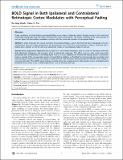BOLD signal in both ipsilateral and contralateral retinotopic cortex with perceptual fading
Author(s)
Hsieh, Po-Jang; Tse, Peter U.
DownloadHsieh-2010-BOLD signal in both ipsilateral and contralateral retinotopic cortex with perceptual fading.pdf (591.1Kb)
PUBLISHER_CC
Publisher with Creative Commons License
Creative Commons Attribution
Terms of use
Metadata
Show full item recordAbstract
Under conditions of visual fixation, perceptual fading occurs when a stationary object, though present in the world and continually casting light upon the retina, vanishes from visual consciousness. The neural correlates of the consciousness of such an object will presumably modulate in activity with the onset and cessation of perceptual fading.
Method
In order to localize the neural correlates of perceptual fading, a green disk that had been individually set to be equiluminant with the orange background, was presented in one of the four visual quadrants; Subjects indicated with a button press whether or not the disk was subjectively visible as it perceptually faded in and out.
Results
Blood oxygen-level dependent (BOLD) signal in V1 and ventral retinotopic areas V2v and V3v decreases when the disk subjectively disappears, and increases when it subjectively reappears. This effect occurs in early visual areas both ipsilaterally and contralaterally to the fading figure. That is, it occurs regardless of whether the fading stimulus is presented inside or outside of the corresponding portion of visual field. In addition, we find that the microsaccade rate rises before and after perceptual transitions from not seeing to seeing the disk, and decreases before perceptual transitions from seeing to not seeing the disk. These BOLD signal changes could be driven by a global process that operates across contralateral and ipsilateral visual cortex or by a confounding factor, such as microsaccade rate.
Date issued
2011-03Department
McGovern Institute for Brain Research at MITJournal
PLoS ONE
Publisher
Public Library of Science
Citation
Hsieh, Po-Jang, and Peter U. Tse. “BOLD Signal in Both Ipsilateral and Contralateral Retinotopic Cortex Modulates with Perceptual Fading.” Ed. Chris I. Baker. PLoS ONE 5.3 (2010) : e9638.
Version: Final published version
ISSN
1932-6203